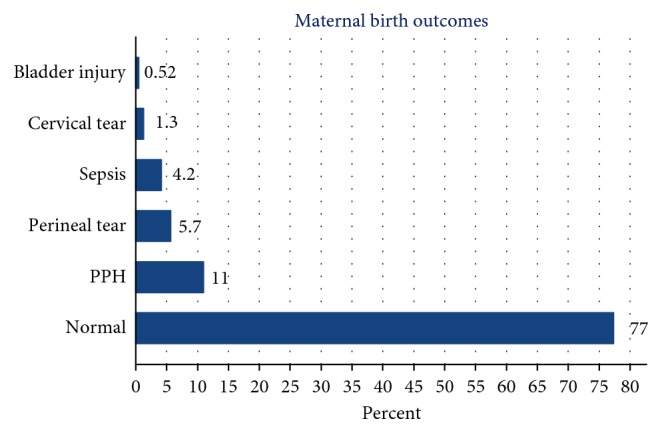Outcomes among Mothers Who Gave Birth in the Health Facility: Does Birth Preparedness and Complication Readiness Have a Role?
IF 1.6
Q3 OBSTETRICS & GYNECOLOGY
Obstetrics and Gynecology International
Pub Date : 2019-04-30
eCollection Date: 2019-01-01
DOI:10.1155/2019/5147853
引用次数: 6
Abstract
Background Giving childbirth is a natural reward for human beings to replace themselves to exist in the world. Despite all the efforts made to improve maternal health, maternal morbidity and mortality continue during childbirth. Hence, this study aimed to determine the proportion of maternal birth outcomes and identify their predictors among mothers who gave birth in hospitals. Method A hospital-based cross-sectional study was conducted from April 9 to June 7, 2016, among 384 postnatal mothers in Debre Tabor Hospital. Randomly selected mothers were interviewed by trained data collectors. Data were checked for completeness, entered using Epi Info version 7, and analyzed using STATA 14 software. A multivariate logistic regression model was used to control confounders and identify predictors of maternal birth outcomes. Statistical significance was declared by adjusted odds ratio with a 95% confidence interval and a p value ≤0.05. Result About 77% (95% CI: 72.9, 81.3) of the mothers had good maternal birth outcomes. Antenatal care utilization (AOR: 2.60; 95% CI: 1.16, 5.83); BPCR practice (AOR: 2.10; 95% CI: 1.12, 3.96); self-preference of health institution (AOR: 2.34; 95% CI: 1.11, 4.50); and mode of delivery: caesarean (AOR: 0.46; 95% CI: 0.23, 0.87), assisted breech (AOR: 0.17; 95% CI: 0.04, 0.69), and instrumental (AOR: 0.27; 95% CI: 0.09, 0.79) were associated with good maternal birth outcome. Conclusion In this study, the maternal birth outcome among postnatal mothers was good in more than three-fourth of the cases. Hence, encouraging mothers to utilize health-care services and counseling and supporting them on BPCR practice are recommended.

在卫生机构分娩的母亲的结局:分娩准备和并发症准备是否有作用?
背景:生育是人类代替自己在世界上生存的一种自然回报。尽管为改善产妇保健作出了种种努力,但产妇在分娩期间的发病率和死亡率仍在继续。因此,本研究旨在确定在医院分娩的母亲分娩结局的比例,并确定其预测因素。方法:对2016年4月9日至6月7日在Debre Tabor医院分娩的384名产妇进行横断面研究。由训练有素的数据收集人员对随机选择的母亲进行访谈。检查数据的完整性,使用Epi Info version 7输入数据,并使用STATA 14软件进行分析。采用多变量logistic回归模型控制混杂因素并确定产妇分娩结局的预测因子。采用校正优势比,p值≤0.05,95%置信区间表示统计学显著性。结果:约77% (95% CI: 72.9, 81.3)的产妇分娩结局良好。产前保健利用(AOR: 2.60;95% ci: 1.16, 5.83);BPCR实践(AOR: 2.10;95% ci: 1.12, 3.96);医疗机构自我偏好(AOR: 2.34;95% ci: 1.11, 4.50);分娩方式:剖腹产(AOR: 0.46;95% CI: 0.23, 0.87),辅助臀位(AOR: 0.17;95% CI: 0.04, 0.69)和工具性(AOR: 0.27;95% CI: 0.09, 0.79)与良好的分娩结局相关。结论:在本研究中,超过四分之三的产后母亲分娩结局良好。因此,建议鼓励母亲利用保健服务和咨询,并在BPCR实践方面为她们提供支持。
本文章由计算机程序翻译,如有差异,请以英文原文为准。
求助全文
约1分钟内获得全文
求助全文
来源期刊

Obstetrics and Gynecology International
OBSTETRICS & GYNECOLOGY-
CiteScore
3.60
自引率
0.00%
发文量
26
审稿时长
19 weeks
期刊介绍:
Obstetrics and Gynecology International is a peer-reviewed, Open Access journal that aims to provide a forum for scientists and clinical professionals working in obstetrics and gynecology. The journal publishes original research articles, review articles, and clinical studies related to obstetrics, maternal-fetal medicine, general gynecology, gynecologic oncology, uro-gynecology, reproductive medicine and infertility, reproductive endocrinology, and sexual medicine.
 求助内容:
求助内容: 应助结果提醒方式:
应助结果提醒方式:


